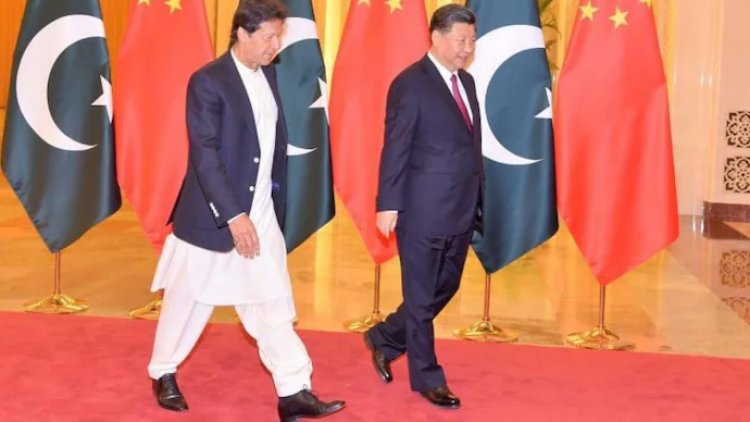Challenge from Pakistan, China: The Bigger Picture
Asia News Agency

Analyst identify two events this year, that have caused speculation about India’s relations with Pakistan and China. The first was an interview Pakistan’s Prime Minister Shehbaz Sharif gave to television the Al-Arabiya channel during his visit to the UAE. He conceded that three wars with India caused unemployment, poverty and economic damage in Pakistan, and added that his nation had ‘learnt its lesson’. However, while seeking normal relations with India, he added the caveat that this could only happen if 'burning issues’ were sorted out. The caveat reflected Imran Khan’s views as well.
Moreover, Pakistan’s foreign minister Bilawal Zardari Bhutto during his visit to the United States made undiplomatic and scathing remarks about the Indian Prime Minister.
The Indian reaction therefore, writes KC Singh (former secretary, MEA) “was less than enthusiastic, even verging on scepticism…..”
The second event, was China lifting its lock to facilitate the listing of Abdul Rahman Makki, the deputy leader of dreaded terrorist outfit Lashkar-e-Tayyaba, as a terrorist by the 1267 UN Sanctions Committee.
Understanding Pakistan’s recent moves
Singh reflects on whether there is some connection between these random events. “Firstly, the context is important. Shehbaz Sharif was in the UAE to solicit financial aid as Pakistan’s financial condition neared meltdown. Pakistan is aware of the personal rapport that Mr Modi has been able to generate with Emirati President Mohammed bin Zayed. It has been an old assessment of Abu Dhabi’s ruling Al Nahyan family that because of their strong relations with both India and Pakistan and the citizens of both nations being present in UAE in dominant numbers, good India-Pakistan relations benefit their nation. It is possible that the United States had a hand in encouraging the Emiratis to mediate.”
Pakistan relations with US improving: At the same time, “relations between the US and Pakistan have also been on the mend of late after the ouster of Mr Imran Khan. The killing by a US drone of Zayman al-Zawaahiri, Al Qaeda’s surviving leader, in Kabul had all the signs of Pakistani intelligence help. The worsened relations between the ruling Taliban in Kabul and Pakistan have been becoming more apparent by the day. This also converges the American and Pakistani assessment of Afghanistan.”
Pakistan’s financial vulnerability: Therefore, argues Singh “the Sharif epiphany may have occurred due more than sudden self-realisation. Pakistan’s financial vulnerability would embolden those bailing it out to try weaning it away from China and embedding it in a peaceful South Asian construct. Logically, only this can provide a sustainable solution to Pakistan’s financial health. As China’s economic rise helped lift Asean nations like Vietnam, a rising India can bring prosperity to all of South Asia, provided of course that India-Pakistan differences stop being a hurdle.”
Elections in India and Pakistan will prevent any breakthrough
However, with India barely a year away from the next Lok Sabha election, and Pakistan too facing a national election this year, with an ascendant Imran Khan threatening to seize power back, “Sharif can’t present Mr Khan any vulnerability that a compromise on their Kashmir stand would constitute. Likewise, in India, with a global economic slowdown likely on the way and its possible impact on India, the Narendra Modi government cannot risk diluting its majoritarian nationalist plank. The peace card appears unplayable in both nations due to domestic political compulsions.”
Chinese challenge on border and its vulnerabilities
China presents a very different challenge. President Xi Jinping, continues his muscle-flexing on the border with India. On January 18, he had a video conference with the PLA forces near the Line of Actual Control (LAC) at Khunjerab and reportedly ‘inspected their combat readiness’. He postulated that ‘in recent years the area has been constantly changing’. Noticeably, the area faces the eastern part of Ladakh where the post-Galwan standoff between India and China still persists in some sectors. This, writes Singh “came as Bhutan sat down to sort out its border issue with China. New Delhi’s nervousness at being outflanked was apparent as the foreign secretary Vinay Kwatra rushed to Thimphu to decipher China’s moves.”
In the circumstance, India needs to introspect but also understand that China is under pressure. This comes, argues Singh from its depleting demographic dividend, low economic growth and continued sanctions being imposed by the USA and its allies on the export of microchips to about 100 Chinese companies which would retard China’s progress in the strategic domain, besides the decision of the Japanese government to term China as an ‘unprecedented strategic challenge’ and increase its defence spending to 2 per cent of its GDP by 2027. Japan is to acquire counterstrike capabilities (aimed mainly against China and North Korea), including new missiles, technologies relating to unmanned systems, cyberspace, outer space, the electromagnetic spectrum and artificial intelligence.
Rising India concerns for China: The other news which would have upset Xi includes in the view of Yogesh Gupta (Former Ambassador) is “about the rising India — the projections of Ernst and Young that the Indian economy could reach $26 trillion by 2046 and the decision of Apple to shift about 25 per cent of American cell phone manufacturing from China to India by 2025 — would not have pleased Xi as China has always aimed at containing India’s progress to assert its supremacy in the region. Xi would view it as another example of the Indo-US collusion aimed at weakening China’s economic power.”
Xi has thus “taken several steps to signal improved relations with the USA…” This may be a tactical move. But this is unlikely to change his attitude towards India.
















